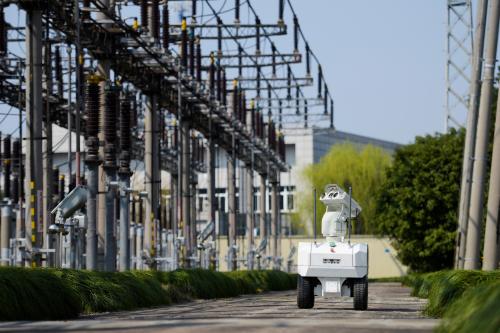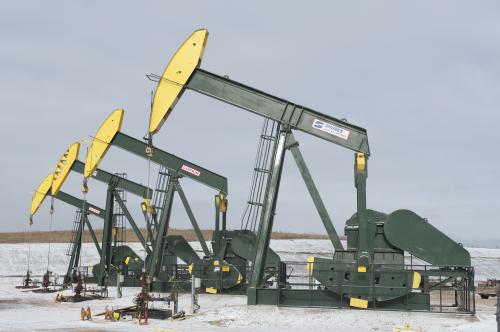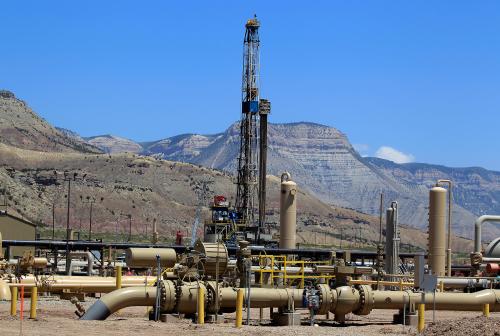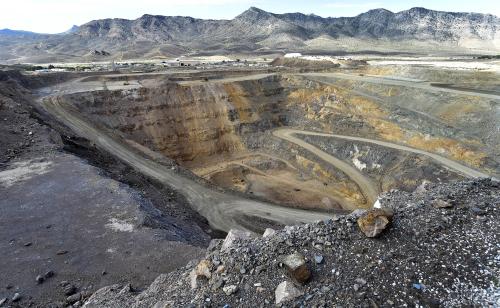Over the past decade, innovation has upended the energy industry, write David Victor and Kassia Yanosek. But this transition will not be straightforward, and could destabilize countries whose economies depend on revenue from traditional energy sources, such as Russia, the big producers of the Persian Gulf, and Venezuela. And it could have wider economic and environmental effects. This article originally appeared in Foreign Affairs.
The technology revolution has transformed one industry after another, from retail to manufacturing to transportation. Its most far-reaching effects, however, may be playing out in the unlikeliest of places: the traditional industries of oil, gas, and electricity.
Over the past decade, innovation has upended the energy industry. First came the shale revolution. Starting around 2005, companies began to unlock massive new supplies of natural gas, and then oil, from shale basins, thanks to two new technologies: horizontal drilling and hydraulic fracturing (or fracking). Engineers worked out how to drill shafts vertically and then turn their drills sideways to travel along a shale seam; they then blasted the shale with high-pressure water, sand, and chemicals to pry open the rock and allow the hydrocarbons to flow. These technologies have helped drive oil prices down from an all-time high of $145 per barrel in July 2008 to less than a third of that today, and supply has become much more responsive to market conditions, undercutting the ability of OPEC, a group of the world’s major oil-exporting nations, to influence global oil prices.
That was just the beginning. Today, smarter management of complex systems, data analytics, and automation are remaking the industry once again, boosting the productivity and flexibility of energy companies. These changes have begun to transform not only the industries that produce commodities such as oil and gas but also the ways in which companies generate and deliver electric power. A new electricity industry is emerging—one that is more decentralized and consumer-friendly, and able to integrate many different sources of power into highly reliable power grids. In the coming years, these trends are likely to keep energy cheap and plentiful, responsive to market conditions, and more efficient than ever.
But this transition will not be straightforward. It could destabilize countries whose economies depend on revenue from traditional energy sources, such as Russia, the big producers of the Persian Gulf, and Venezuela. It could hurt lower-skilled workers, whose jobs are vulnerable to automation. And cheap fossil fuels will make it harder to achieve the deep cuts in emissions needed to halt global warming.
GET SMART
There are three trends driving the new energy revolution: smarter management of complex systems, more sophisticated data analytics, and automation. The first trend has allowed companies to become much more efficient while drilling for oil and gas in ever more complex geological environments. Beginning around 15 years ago, for example, advances in imaging technology made it easier for companies to find oil deposits in deep waters, such as in the Gulf of Mexico and off the coast of Brazil. But as oil and gas companies rushed to recover these resources, the technological demands of operating in deep waters and through thick layers of sediment and bedrock drove up costs. By 2014, new deep-water projects were so costly that many broke even only when the price of oil was at almost $100 per barrel. As the price of oil tumbled from above $100 per barrel in early 2014 to below $50 per barrel in January 2015, many of these projects stalled. By early 2016, companies had put on hold an estimated four million barrels per day of new oil output, 40 percent of it from deep-water sources.
As drilling stalled, oil and gas operators, desperate to cut costs, began to rethink the complex systems they used. Some savings were easy to find: reduced activity meant that critical equipment and services, once scarce, now sat idle. The daily cost of renting an oil rig, for example, fell by half. But the industry is also cutting costs and improving performance through fundamental productivity improvements. Simpler, standardized designs make drilling and production platforms easier to replicate, less expensive, and less likely to suffer costly delays and overruns in construction. And companies are transferring the lessons they’ve learned across the industry. Shell, for example, recently announced that it is applying techniques from onshore shale operations, such as drilling horizontal wells and injecting water into them, to increase production in mature deep-water fields.
Today, thanks to these innovations, the average breakeven prices of new deep-water projects have fallen, to just $40–$50 per barrel in the Gulf of Mexico—an important global bellwether because it is one of the most responsive regions in the world to changes in market conditions. Even though oil prices remain low (and many in the industry expect them to stay low), investment is once again growing. Ten deep-water projects were approved for investment in 2016 and the first half of 2017 alone.
Smarter management of complex systems is also reshaping the electric power industry. For decades, centralized, base-load energy generators—mainly coal, nuclear, and large hydro- electric plants—dominated the industry. But in the last two decades, governments have subsidized wind and solar energy and pushed them into the electricity system, in the hopes of diversifying their countries’ energy sources, creating new jobs, and reducing emissions. Until recently, these new sources were too small to have much of an effect on the overall system.
Today, however, as the cost of renewables is plummeting and their share of the power supply is rising, they have begun to transform electricity markets. In Germany, wind and solar power account for almost 30 percent of the power mix; in Hawaii, they account for about a quarter. Traditional utilities have struggled to adapt. In March, grid operators in California shut down 80 gigawatt-hours of the state’s renewable power because the grid couldn’t handle the afternoon solar surge; without more capacity to store power, even larger curtailments will occur. In Texas, among many other places, prices occasionally turn negative when the wind is blowing hard but people don’t need too much electricity—in other words, companies are paying customers to use the electricity they generate. Utilities that have failed to see these changes coming have floundered. The market valuations of the top four German utilities are about one-third the level they were a decade ago—in large part because they were stuck with the costs of the old electric power system even as the government provided lavish support for renewables.
Renewables are just one part of this transformation. In the coming years, utility companies may face an existential challenge from smaller and more decentralized energy systems known as “microgrids.” Microgrids first emerged decades ago, driven by customers, such as the U.S. military, that prized reliability above all else and that did not mind paying more for it: military bases have to keep functioning even if the bulk power grid fails. Early adopters also included remote communities, such as in Alaska, that are far from the conventional grid. But now, microgrids are spreading to other places, such as university campuses and hospitals, where they generate reliable power and are often designed to save money by using waste energy to heat and cool buildings.
New technologies, such as fuel cells and battery storage systems (to store extra power produced by renewables), along with more sophisticated software, have led to even smaller systems called “nanogrids,” which Walmart and other megastores have begun to adopt. And picogrids may be next. As more and more people rely less on the traditional grid for power (while still interconnecting with it to help ensure reliability), policymakers and companies will need to create new regulatory systems and business models. Some states, such as New York, have embraced these changes, aggressively promoting decentralization by rewarding companies that invest in decentralized systems. But no one has yet worked out a detailed plan for how to integrate new grids with traditional power systems.
HI, ROBOT
The second major source of innovation is better data analytics. Oil companies, for example, have begun to use complex algorithms to analyze massive amounts of data, making it easier for them to find oil and gas and to manage production. In April 2017, for example, bp announced that, using these methods, it had identified another 200 million barrels of oil in an existing field in the Gulf of Mexico. According to bp, data crunching that used to take a year now takes just a few weeks. And cloud processing makes it possible to generate millions of scenarios for developing an oil field. When firms can evaluate more options, production from fields can rise by five percent, with a 30 percent cut in the investment required to drill holes and begin producing oil. The industry has also begun to use data analytics for “predictive maintenance,” reducing unplanned downtime by analyzing historical data to predict equipment failures before they happen. This practice, pioneered by industries such as the aircraft engine business, is helping cut costs on oil and gas rigs, where compressors and other rotating equipment can cause costly interruptions when they fail.
The third and most important trend is automation. In remote offshore oil fields, robots have already begun to perform dangerous tasks, such as connecting pipes during drilling operations, a job traditionally carried out by the versatile workers known as “roustabouts.” Soon, intelligent automated systems will enable remote drilling, controlled almost entirely by a handful of high-tech workers in onshore data rooms hundreds of miles away. And companies are developing robots that can live on the ocean floor and inspect offshore pipe lines and underwater equipment. At the moment, offshore oil rigs typically employ 100–200 workers, a figure that could fall. Although people remain indispensable for critical safety roles that require complex decisionmaking, automation will transform the industry’s work force. According to a McKinsey study, within ten years, oil and gas companies could employ more data scientists with Ph.D.’s than geologists.
Automation has already changed the power industry, where smart meters have all but eliminated manual meter readings. In the future, automation, along with better data analytics, will make it easier to manage the variation in supplies that comes from using renewable sources such as wind and solar energy and more complex, decentralized grids. It can also make the grid more reliable. The inability of grid operators to understand what is happening in real time plays an important role in many power outages; automation and improved human-computer interaction could make blackouts much rarer.
Yet innovation can create new problems. Automation in the energy business, for example, could make it more difficult for governments to perform some of their traditional functions, such as safety regulation. When technological changes on rigs, production platforms, and grids proceeded slowly, regulators could keep up, learning and applying lessons from occasional failures. Today, the sheer complexity of highly automated systems makes observing and predicting their behavior much more difficult. So regulators will need to evolve as quickly as the industry—and develop early warning systems to identify places where oversight is required. They will need to learn more rapidly from each other. Regulators in other countries could study the Norwegian offshore oil and gas regulatory body, for example, which is becoming adept at managing the high levels of uncertainty inherent in the offshore industry, or they could learn from the U.S. nuclear industry, which has figured out how to use peer review inside the industry to judge the management of plants.
WINNERS AND LOSERS
The coming transformation of the energy industry is, for the most part, good news for the world. But as the revolution unfolds, it will profoundly change politics, economics, and the environment. Policymakers and business leaders will need to tread carefully.
[A]s the revolution unfolds, it will profoundly change politics, economics, and the environment.
For starters, sustained lower energy prices could weaken the economic and geopolitical influence of many major oil suppliers, which have relied for too long on their control of nearly all of the world’s cheap oil resources. In response, some of these countries have begun to act. Last year, for example, Saudi Arabia launched Vision 2030, a program to reduce the kingdom’s dependence on oil and diversify its economy. The government has announced plans to sell around five percent of the state oil giant, Saudi Aramco—the kingdom’s crown jewel—in an initial public offering next year, which may help the firm become more efficient. These reforms are promising and long overdue, but they face significant resistance, and whether they can be successfully implemented remains to be seen.
Russia, too, must continue to reform. A decade ago, the Russian government could balance its budget only when the price of oil topped $100 per barrel. Today, however, the country expects to balance its budget by 2019 with oil at just $40 per barrel, even though 35 percent of the government’s revenue still comes from hydrocarbons. But this situation remains unstable, and Moscow will have to continue cutting its expenditures. Other countries, such as Angola and Nigeria, have failed to introduce sufficient reforms, and the fall in energy prices has contributed to their instability. Fiscal prudence and a more reliable environment for foreign investors would help local industries get access to the latest technologies and compete in international energy markets.
In the United States, the energy revolution will have profound effects far beyond the jobs and economic growth that cheap energy will catalyze. When it comes to electricity, the economics increasingly favor natural gas and renewables—making it even harder for coal, which accounted for almost half of U.S. electricity generation in 2007 but just 30 percent in 2016, to compete, no matter what politicians may claim. Most coal jobs are not coming back.
The United States has not yet had a well-informed public debate about how the nature of work in the modern economy is changing. The energy industry has witnessed this transformation firsthand and is well positioned to show how the work force itself can adjust. Energy companies, for example, have begun to figure out how to retrain workers over the course of their careers as jobs in power plant control rooms and on production platforms shift toward the overseeing of automated systems. Education and training are changing, too. Texas A&M, for example, is launching a master’s degree in geospatial technologies specifically targeted for the oil and gas work force.
Climate change remains perhaps the greatest challenge of all. According to the latest assessment from the Intergovernmental Panel on Climate Change, the world will need to cut emissions by about 80 percent if it is to slow and, eventually, stop the rise in global temperatures. The last two decades of summits and negotiations have shown that this will not be easy. And the revolution in fossil fuel production may make it even more difficult, because the prices of carbon-based fuels are likely to remain highly competitive with those of their lower-emission rivals. The solution lies in part in investing more in innovation, and at the Paris climate change conference in late 2015, the world’s biggest governments pledged to double their spending on energy R & D. So far, however, they have not delivered. Although there has been an uptick in private-sector investment, across the industrialized world, government spending on energy R & D has remained roughly flat for almost four decades.
Already, huge benefits from the technology revolution in energy are reaching consumers. The 92 million barrels of crude oil that the world economy consumes every day cost about $2 trillion less annually than that amount did a decade ago. In the United States, the energy revolution has helped sustain economic growth: from 2008 to 2014, lower prices saved the average household over $700 a year. The era in which energy policy focused on the security of raw resource supplies—access to barrels of crude oil, tons of coal, and volumes of natural gas—is over. Today, the task for policymakers is to manage the implications of a new world of cheap, plentiful energy.
The Brookings Institution is committed to quality, independence, and impact.
We are supported by a diverse array of funders. In line with our values and policies, each Brookings publication represents the sole views of its author(s).











Commentary
The next energy revolution: The promise and peril of high-tech innovation
June 13, 2017